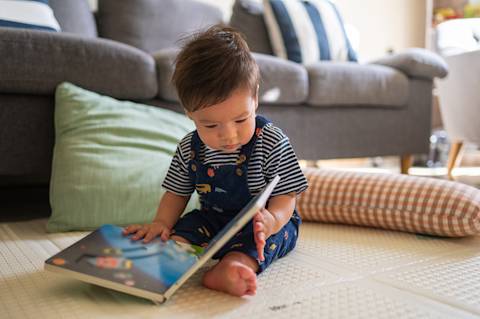Discipline is often most effective when it’s consistent and predictable for children. If the expectations continue to change, children might get confused about how to act in specific situations. It’s important for both caregivers to co-develop boundaries, expectations, and approaches to discipline and then apply those consistently.

Some caregivers find it helpful to talk through specific scenarios and how they plan to set behavior expectations with their child and apply consequences if those expectations aren’t met. In the examples below, you can explore different ways to respond, helping you choose the style that might work best for your family.
Scenario 1: Your child cries because they don’t get a toy they want during a shopping trip.
Before going to the store, many caregivers prefer to set clear expectations about acceptable behavior, explaining that misbehavior will result in losing an agreed-upon privilege. By creating boundaries ahead of time, children can understand what’s expected of them and the consequences of their actions.
Another approach is to create a reward system for good behavior during the shopping trip. Caregivers can promise a small treat, like extra time at the park or playing with a special toy. It’s important to avoid using food as an incentive—we want children to see food as fuel for their bodies, not as something they need to earn.
If misbehavior does happen, some caregivers prefer to start by acknowledging the child's emotions and empathizing with their feelings of anger or frustration. They can help the child label and understand their emotions, and the caregiver and child can work together to develop strategies to cope with those big feelings in a healthier way.
Scenario 2: Your child refuses to share toys with a sibling or playmate.
Before playtime, many caregivers explain to their child that sharing is expected, and if they aren’t able to share, they will face a consequence such as a time-out or removal of the toy. Caregivers can also explain the importance of sharing and taking turns so the child understands why the caregiver expects them to share.
Praising positive sharing behaviors can encourage children to behave appropriately. If a disagreement happens, caregivers can acknowledge the child's feelings about not wanting to share. The caregiver can guide the child towards understanding the importance of sharing by asking how they would feel if others didn't share with them. This approach nurtures the development of empathy and consideration for others. The caregiver and child can then brainstorm solutions together, like using a timer to show children when their turn with the toy is up.
Scenario 3: Your child is consistently not following bedtime routines.
Many caregivers focus on establishing clear expectations for the bedtime routine and enforcing consequences, such as losing a privilege, if the child consistently resists the routine. An alternative method involves creating a reward system for following the bedtime routine. Caregivers can offer incentives, such as a special bedtime story or a small non-food treat, for each successful night. If the child continues to resist the routine, applying a consequence like a brief time-out before attempting the routine again can reinforce the importance of bedtime routines.
Caregivers can try acknowledging the child's feelings about wanting more playtime and work together to find solutions that help the child successfully complete their bedtime routine. Involving the child in decisions, such as creating a routine chart or offering a special activity together before bed if they follow the routine, can empower the child and encourage cooperation.
It can also be helpful for caregivers to patiently address the child's fears or concerns about bedtime while offering comfort and reassurance so they feel more secure at night. This method helps to establish trust and connection between the caregiver and child, leading to more consistent bedtime routines.
Scenario 4: Your child has difficulty transitioning between activities, such as going from playtime to mealtime.
Caregivers can try rewarding the child for successful transitions using praise, stickers, or offering to do a special activity together if they follow the rules. Some caregivers find it helpful to use tools like timers or cues, such as playing a specific song, to help signal transition times. If the child becomes overly upset during the transition, consequences like a brief time-out can be applied to refocus their attention and establish the importance of transitioning smoothly.
If a conflict happens, some caregivers prefer to empathize with the child about the challenges of transitioning between activities and encourage the child to express their feelings. By offering support and providing coping strategies for handling transitions more comfortably, the caregiver can help the child better understand their big feelings. The caregiver and the child can brainstorm solutions to make transitions smoother, such as creating a special song or dance to signal the shift between activities, empowering the child in the process and giving them a sense of control.
Scenario 5: Your child exhibits aggressive behavior towards other children or caregivers, such as hitting or biting.
When addressing a child's aggressive behavior, caregivers can use various discipline strategies to promote appropriate emotional expression. Before the aggressive behavior starts, caregivers can establish clear rules with consequences like time-outs or loss of privileges. Reinforce positive behaviors using praise and rewards.
When an issue happens, many caregivers find it helpful to remove the child from the situation. When they’ve calmed down, it can be a good time to talk about the child's emotions, validating any feelings of anger, frustration, or fear that led to the conflict. Then, the child and caregiver can work together to explore alternative ways to express feelings in a healthy and non-harmful way, like talking or drawing.






